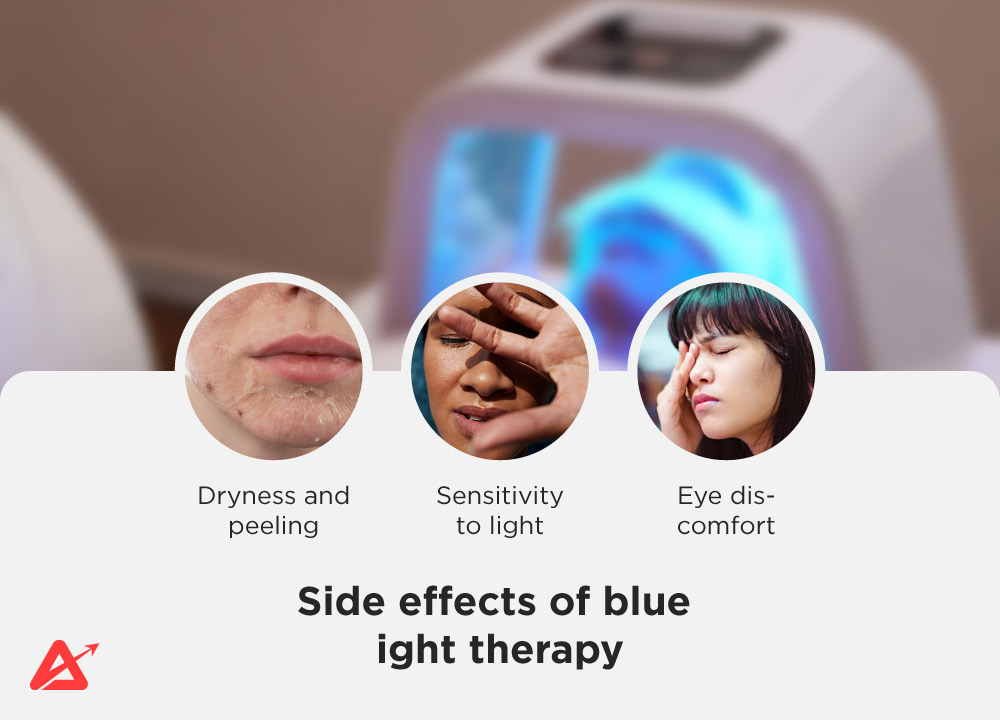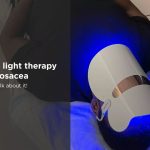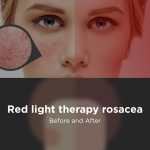Rosacea is a chronic skin condition characterized by facial redness, visible blood vessels, and small, pus-filled bumps. While there is no cure for rosacea, various treatments can help manage its symptoms. One such effective treatment is blue light therapy. In this blog post, we will explore blue light therapy as a viable option for rosacea management.
What Is Blue Light Therapy?
Blue light therapy for rosacea is a non-invasive procedure. That utilizes a specific wavelength of light to target and eliminate the bacteria associated with rosacea. The blue light emitted during the treatment reaches the deeper layers of the skin. Promoting a natural healing response and reducing inflammation. Unlike other treatments, blue light therapy does not involve any chemicals or harsh side effects.
The Benefits Of Blue Light Therapy For Rosacea
Blue light therapy has been recognized as an effective treatment option for rosacea. A chronic skin condition characterized by redness, flushing, and the appearance of small blood vessels on the face. Here are some of the benefits of blue light therapy for rosacea:

| Reduction of inflammation: Blue light therapy has anti-inflammatory properties that can help decrease the inflammation associated with rosacea. | Improved vascular symptoms: Rosacea often involves dilated blood vessels, resulting in visible redness and flushing. Blue light therapy can help shrink these blood vessels, leading to a reduction in redness and a more even skin tone. |
| Non-invasive and painless treatment: Blue light therapy is a non-invasive procedure that does not require any surgical intervention. It is typically painless and does not cause any significant discomfort during or after the treatment. | Minimal side effects: Blue light therapy is generally considered safe with minimal side effects. |
| Convenient and quick procedure: Blue light therapy sessions are usually short and can be completed in a matter of minutes. Depending on the severity of rosacea and the specific device used, multiple treatment sessions may be recommended to achieve optimal results. | Complementary to other treatments: Blue light therapy can be used in combination with other treatments for rosacea, such as topical medications or oral antibiotics. It can enhance the overall effectiveness of the treatment regimen and provide additional benefits for managing the symptoms of rosacea. |
It’s important to note that while blue light therapy can be beneficial for many individuals with rosacea, results may vary depending on the severity of the condition and individual response to the treatment.
LED light therapy has shown promise in managing Rosacea symptoms by reducing inflammation and improving overall skin appearance. You may also want to know more about Is LED Light Therapy Good For Rosacea?
Blue Light Treatment
Blue light treatment, also known as blue light therapy or photodynamic therapy, is a non-invasive medical procedure used to treat various skin conditions. It involves exposing the affected area to a specific wavelength of blue light, typically between 405 and 420 nanometers.
This light activates a photosensitizing agent applied to the skin, resulting in a chemical reaction that destroys targeted cells or bacteria. Blue light treatment is particularly effective in combating acne, as it kills the bacteria responsible for its development.
It also reduces sebum production and inflammation, resulting in clearer skin. Additionally, this therapy can be used to treat precancerous lesions, sun damage, and certain types of skin cancer.
Blue light treatment offers a promising solution for individuals seeking safe and effective treatments for various skin conditions, improving both their appearance and overall well-being.
How Does Light Therapy Help?
Light therapy works by exposing individuals to bright light, typically mimicking natural sunlight. This exposure helps regulate circadian rhythms, which play a crucial role in our sleep-wake cycle and overall well-being.
The light stimulates the production of serotonin, a neurotransmitter that affects mood and happiness. Additionally, light therapy can suppress the production of melatonin, a hormone that regulates sleep patterns.
By restoring the balance of these chemicals, light therapy can alleviate symptoms of SAD, including low mood, fatigue, and lack of energy. Moreover, it has been used to treat certain sleep disorders, jet lag, and skin conditions such as psoriasis.
It’s important to note that light therapy should be conducted under professional guidance, as the duration, intensity, and timing of light exposure vary based on individual needs.
Blue Light Therapy At Home
Blue light therapy is a popular treatment option that can now be conveniently conducted at home. This therapy involves exposure to blue light, typically using specialized LED devices. The benefits of blue light therapy include its potential to alleviate various skin conditions, such as acne and psoriasis.
It works by killing bacteria, reducing inflammation, and promoting skin healing. By bringing this therapy into the comfort of your own home, it offers convenience, cost-effectiveness, and privacy. Home blue light therapy devices are user-friendly and adjustable, allowing individuals to customize their treatment according to their specific needs. However, it is essential to follow guidelines and safety precautions to ensure optimal results and minimize potential risks.
With at-home blue light therapy, individuals can enjoy the benefits of this non-invasive treatment whenever it is most convenient for them.
Is Blue Light Therapy Good For Rosacea?
Blue light therapy has shown promising results in the treatment of rosacea. This non-invasive procedure utilizes specific wavelengths of blue light to target and destroy bacteria associated with the condition, reducing inflammation and redness.
Blue light therapy also helps to regulate oil production and improve overall skin texture. The treatment is generally well-tolerated and does not require downtime.
However, it is important to note that individual results may vary, and it is advisable to consult with a dermatologist before undergoing any therapy. They can evaluate the severity of your rosacea and determine if blue light therapy is a suitable option for you.
What Are The Side Effects Of Blue Light Therapy For Rosacea?

Blue light therapy is a common treatment for rosacea, a chronic skin condition characterized by redness and inflammation. While generally safe, there are potential side effects to be aware of:
- Temporary redness and swelling: Following blue light therapy sessions, some individuals may experience a temporary exacerbation of redness and swelling in the treated areas. This usually subsides within a few hours or days.
- Dryness and peeling: Blue light therapy may lead to temporary dryness and peeling of the skin. This can be managed with moisturizers and gentle skincare products.
- Sensitivity to light: Blue light therapy increases the skin’s sensitivity to sunlight. It is important to protect the treated areas from direct sun exposure and use sunscreen regularly.
- Eye discomfort: Although protective goggles are typically worn during treatment, some individuals may experience eye irritation or discomfort. Inform the healthcare provider if this occurs.
It is crucial to consult a dermatologist before undergoing blue light therapy to discuss potential side effects and determine its suitability for individual needs.
Does Blue Light Reduce Redness?
lue light has been shown to have potential benefits in reducing redness, particularly in certain skin conditions. Here are some key points to consider:
- Targeting inflammation: Blue light therapy can help reduce redness associated with inflammatory skin conditions like acne, rosacea, and sunburn. It has antimicrobial properties that can help kill bacteria responsible for acne, while also calming inflammation.
- Photodynamic therapy: Blue light is used in combination with a photosensitizing agent in a treatment called photodynamic therapy (PDT). This treatment can effectively target and reduce redness caused by conditions such as actinic keratosis and certain types of skin cancer.
- Vascular constriction: Blue light has the ability to constrict blood vessels, which can help decrease redness in the skin. This mechanism is particularly useful in managing redness associated with rosacea.
- Circadian rhythm regulation: Exposure to blue light during the day helps regulate the circadian rhythm and promotes a healthy sleep-wake cycle. This indirectly contributes to skin health by reducing stress and promoting overall well-being, potentially improving redness and inflammation.
- Personal experiences may vary: It’s important to note that individual responses to blue light therapy may vary. The effectiveness of this treatment depends on factors such as the underlying cause of redness, skin type, and treatment protocol.
While blue light shows promise in reducing redness, it is essential to consult a dermatologist or healthcare professional to determine the most suitable treatment approach for your specific condition.
Is Blue Light Safe For The Face?
Blue light exposure has become a concern due to increased screen time and the use of electronic devices. Here are some points to consider regarding its safety for the face:
- Blue light exposure from screens and devices is relatively low compared to natural sunlight, which contains a wider spectrum of light.
- While some studies suggest that blue light may contribute to skin aging and pigmentation, the levels emitted by screens are unlikely to cause significant damage.
- Blue light may have some benefits for acne treatment, as it can kill certain bacteria that contribute to breakouts.
- However, prolonged exposure to screens can cause eye strain, disrupted sleep patterns, and potential indirect skin issues like fatigue-induced dullness or rubbing the face while using devices.
- To minimize any potential negative effects, it’s advisable to take breaks from screens, use screen filters or blue light-blocking glasses, and maintain a consistent skincare routine.
- Overall, using electronic devices in moderation and taking appropriate precautions can help ensure blue light exposure remains safe for the face.
Blue Light Therapy For Rosacea Reviews
Blue light therapy for rosacea has received positive reviews from many individuals who have used it to manage their condition. This non-invasive treatment involves exposing the affected skin to specific wavelengths of blue light, which can help reduce inflammation and kill bacteria associated with rosacea.
Users have reported improvements in redness, flushing, and the appearance of visible blood vessels. Blue light therapy is generally well-tolerated, with minimal side effects such as temporary dryness or mild irritation.
However, it’s important to note that individual results may vary, and it’s advisable to consult a dermatologist to determine if blue light therapy is suitable for your specific case of rosacea.
There is also red light therapy for rosacea which you can learn about before and after use. Red light therapy is also very good for the skin.
Conclusions
Blue light therapy for rosacea offers a promising treatment option for individuals with rosacea, helping to reduce inflammation and improve overall skin appearance. By following this step-by-step guide, you can confidently navigate the process of blue light therapy.
Remember, it is essential to consult with a dermatologist who can provide personalized advice based on your unique circumstances. With proper care and adherence to post-treatment instructions, blue light therapy can be an effective tool in your journey toward managing rosacea and achieving healthier, clearer skin.






